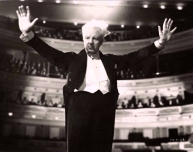
Leopold Stokowski
In the late 1940s and early 1950s, Leopold Stokowski would lead a symphony orchestra that was comprised of top classical musicians through some now-legendary recording sessions. The ensemble never really existed to perform anywhere, but was put together with hand-picked musicians by Maestro Stokowski for the sole reason to produce records. There were players from Philadelphia, The New York Philharmonic, the NBC

Robert Bloom
Symphony Orchestra, and so on. Stokowski’s choice for principal oboe was always Robert Bloom. My teacher, Engelbert Brenner was often present on these recordings as the English horn player.
Mr. Brenner was a great story teller, and would spell my embouchure during long lessons by telling stories from his long and illustrious career as oboist and English hornist of both the Cleveland Orchestra and later the New York Philharmonic.

Engelbert Brenner
On one particular recording session, the Jacques Ibert piece, “Escales” (Ports of Call) was recorded. The 2nd of the 3 movements is all oboe solo, playing an exotic, dance melody that stretches from the bottom to the top of the instrument’s range. It is haunting to hear, and daunting to play. Robert Bloom was a wonderful oboist, and his playing of this hallmark oboe solo would be one for generations to listen to, enjoy and learn from.
Unfortunately, the recording session was not going as smoothly as all musicians and technicians had hoped. Mister Bloom’s oboe solo movement was not going well, and sessions back in the 1940s & 50s were not like those of today, where a missed note could be patched in, or dynamics could be digitally manipulated. If a tape splice was required, it was nervously done with a razor blade and tape to reassemble the edit.
The oboe solo is loaded with low Ds, and the solo ends on an extended one that diminuendos from p to ppp. It was becoming apparent to Brenner, as the takes started to mount up, that Bloom’s low Ds were becoming less and less stable, and they were dropping off abruptly and early. Neither Bloom nor Stokowski was happy with any of the takes, and the tension in the room was mounting. After a break, one more take was to be attempted. The first portion of the solo was played beautifully. The middle section, which extends the range up high, also went well, as did the small cadenza. The final recap of the main melody was all that was left, but Bloom was exhausted, and his low Ds were on everyone in the room’s mind. The repeated first low D didn’t speak – but it was there. How? Engelbert Brenner, playing English horn next to him, whispered the note out, covering up the note slip. The movement continued. From that point out, Brenner played the Ds on his English horn, spelling the now exhausted Bloom. When the movement ended, Stokowski wrapped up the movement quickly, and moved on to the final movement.
At a gathering later, Robert Bloom received praise from either Stokowski or another musician in the orchestra (I don’t recall who Brenner said it was) on how he was finally able to make that last low D fade away to nothing after such a grueling and tense number of takes. Mr. Bloom humbly acknowledged that the beautiful low Ds at the end were actually played by Engelbert Brenner.
 Why am I telling this story now? When Brenner relayed this story to me, there was no YouTube or Google in which one would research stories like this. Brenner was one of the three musicians mentioned in this story, so he would know how things played out that day. I always wanted to hear that recording, having been let in on its interesting back-story. But before the internet, I would look in used record stores to see if I could locate a copy, and never did. Over the decades, it eventually slipped my mind and I stopped searching. The other day, I was reading an online article about Stokowski and His Orchestra. It mentioned some of the players used for the recordings, and Mr. Bloom’s name was included. This triggered the incident in my mind, and I went to work combing the internet for a copy of the recording. FOUND IT!
Why am I telling this story now? When Brenner relayed this story to me, there was no YouTube or Google in which one would research stories like this. Brenner was one of the three musicians mentioned in this story, so he would know how things played out that day. I always wanted to hear that recording, having been let in on its interesting back-story. But before the internet, I would look in used record stores to see if I could locate a copy, and never did. Over the decades, it eventually slipped my mind and I stopped searching. The other day, I was reading an online article about Stokowski and His Orchestra. It mentioned some of the players used for the recordings, and Mr. Bloom’s name was included. This triggered the incident in my mind, and I went to work combing the internet for a copy of the recording. FOUND IT!
Just as told to me, and over 30 years ago, you can hear the first repeated low D after the cadenza played by the oboe, but its re-attack has a different timbre, as the whole note is being played in the middle range of an English horn, not the bottom of the oboe’s range. The 4 beat rest that Brenner offered Mr. Bloom made this important recording possible. The assistance was not agreed upon in advance. Brenner knew an esteemed colleague was having difficulty, and did what he could to help. And after all these years, I have finally heard this story’s results.
Here is the original YouTube recording I located:
YouTube Excerpt
and here it is again in a different format.
Escales mvt.2
Mr. Bloom’s playing and interpretation is wonderful… and listen carefully for the moments mentioned in the last recap of the main melody. ENJOY.
As a postscript, I met Robert Bloom in the repair shop of Hans Moennig. Moennig introduced us, and told Bloom that I was a Bert Brenner student. Bloom was extremely complementary about his working with Brenner over the years, and stated that his character and playing were of the highest standard.





 Why am I telling this story now? When Brenner relayed this story to me, there was no YouTube or Google in which one would research stories like this. Brenner was one of the three musicians mentioned in this story, so he would know how things played out that day. I always wanted to hear that recording, having been let in on its interesting back-story. But before the internet, I would look in used record stores to see if I could locate a copy, and never did. Over the decades, it eventually slipped my mind and I stopped searching. The other day, I was reading an online article about Stokowski and His Orchestra. It mentioned some of the players used for the recordings, and Mr. Bloom’s name was included. This triggered the incident in my mind, and I went to work combing the internet for a copy of the recording. FOUND IT!
Why am I telling this story now? When Brenner relayed this story to me, there was no YouTube or Google in which one would research stories like this. Brenner was one of the three musicians mentioned in this story, so he would know how things played out that day. I always wanted to hear that recording, having been let in on its interesting back-story. But before the internet, I would look in used record stores to see if I could locate a copy, and never did. Over the decades, it eventually slipped my mind and I stopped searching. The other day, I was reading an online article about Stokowski and His Orchestra. It mentioned some of the players used for the recordings, and Mr. Bloom’s name was included. This triggered the incident in my mind, and I went to work combing the internet for a copy of the recording. FOUND IT!











Recent Comments